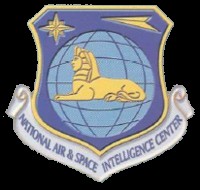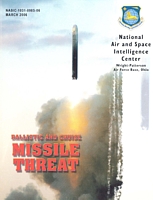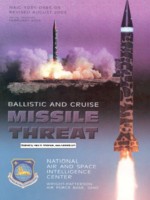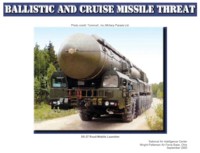Air Force Threat Assessments
 The
National Air and Space Intelligence Center (NASIC) at Wright-Patterson
Air Force Base is tasked to "produce integrated, predictive air and
space intelligence to enable military operations, force modernization
and policymaking." One of NASIC's products is the glossy magazine
Ballistic and Cruise Missile Threats, which is updated periodically. The
publication gives a brief overview of the ballistic missiles and cruise
missiles of Russia, China, India, Pakistan, North Korea and Iran.
British, French, German and South African export cruise missiles are
also described. NASIC does not make this information available on their
web site, so the last two versions of Ballistic and Cruise Missile
Threats are made available here: The
National Air and Space Intelligence Center (NASIC) at Wright-Patterson
Air Force Base is tasked to "produce integrated, predictive air and
space intelligence to enable military operations, force modernization
and policymaking." One of NASIC's products is the glossy magazine
Ballistic and Cruise Missile Threats, which is updated periodically. The
publication gives a brief overview of the ballistic missiles and cruise
missiles of Russia, China, India, Pakistan, North Korea and Iran.
British, French, German and South African export cruise missiles are
also described. NASIC does not make this information available on their
web site, so the last two versions of Ballistic and Cruise Missile
Threats are made available here:Ballistic
and Cruise Missile Threats, March 2006
 In
tune with other recent Defense Department publications, the
2006 NASIC report highlights China as a threat and even presents a
new and higher projection for the future development of China's nuclear
forces than is normally done by the U.S. intelligence community. In
tune with other recent Defense Department publications, the
2006 NASIC report highlights China as a threat and even presents a
new and higher projection for the future development of China's nuclear
forces than is normally done by the U.S. intelligence community.
The
2003 NASIC report stated that the "number of warheads on Chinese
ICBMs capable of threatening the United States is expected to expand to
75-100 over the next 15 years." The new report, however, states that
"the number of warheads on Chinese ICBMs capable of threatening the
United States is expected to grow to well over 100 in the next 15
years." (Emphasis added)
The new estimate is both higher and different from
that normally used by the U.S. intelligence community. The 75-100
warhead range comes from the CIA's National Intelligence Estimate
published in 2001, which predicted that the number of warheads
primarily targeted against the United States may increase to 75-100
by 2015. But since not all Chinese ICBMs will be primarily targeted
against the United States but some against Russia and India, the 2003
statement is inconsistent with the estimate made by the CIA in 2001 and
well above the force level envisioned by the U.S. intelligence
community.
Moreover, whereas the 2001 CIA estimate envisioned
China would reach the increased warhead level by 2015, the new NASIC
estimate stretches another six years to 2021.
NASIC also states that future Chinese ICBMs could
include some with multiple independently targetable reentry vehicles, a
apparent shift from previous NASIC reports which did not make this
prediction. The U.S. intelligence community has consistently stated that
it only expected the DF-5 (CSS-4) might be equipped with multiple
warheads.
Contrary to claims by media and "experts," the NASIC
does not believe the DF-31 ICBM has yet been operationally deployed.
This may happen "soon," the new report states. NASIC also increases its
range estimate for the CSS-2 (DF-3) from 1,750 to 1,900 miles (3,058
km).
NASIC has also significantly raised its estimate for
the number of DF-11 (CSS-7) and DF-15 (CSS-6) launchers from "less that
50" (each) in 2003 to "fewer than 150" and "fewer than 100,"
respectively, in the new report. The 2006 report also includes a new
Chinese SRBM, identified as the B611, which is said to be a
solid-fueled, road-mobile missile with a range of 93 miles.
Two Chinese land-attack cruise missiles are introduced
in the new NASIC report, the YJ-63 and an unnamed missile. Neither are
said to be deployed yet, but the unnamed cruise missile is credited with
a "conventional or nuclear) warhead.
Russia is said to continue high investments in
upgrading its nuclear forces. The 2006 NASIC report states that Russia
has several thousand nuclear warheads deployed, including almost 2,000
alert warheads on ICBMs that can be launched within minutes, that are
capable of reaching the United States. In addition to existing missiles,
a new ICBM is under development, as well as a modified SS-N-23 (Sineva)
with up to 10 warheads compared with 4 for the current SS-N-23. NASIC
continues to include the SS-N-20 in its estimate (albeit at a slightly
reduced number compared with 2003), although the missile is widely
reported to have been withdrawn from service in 2004. Two Russian
short-range ballistic missiles (SRBMs), the SS-Ic Mod 2 (SCUD B) and
SS-23, that were included in the 2003 report are not included in the new
report.
India's nuclear deployment is described in modest
terms. In contrast with claim by the Indian Government that the Agni I
missile was "inducted into Army service" in 2004, the new NASIC report
states that the missile has not yet been operationally deployed. The
report also increases the range estimate for the Dhanush ship-based SRBM
from 155 to 250 miles. In contrast with claims made by media and
"expert," the NASIC does not believe that the Brahmos-A cruise missile
has nuclear capability.
Pakistan is said to have operationally deployed the
Shaheen I with "fewer than 50" launchers deployed. The solid-fueled
road-mobile missiles is said to have a maximum range of 250 miles. The
Half-I is also operational with "fewer than 50" launchers deployed, a
change from "undetermined" in the 2003 report. NASIC asserts that
Pakistan's new 200-miles range Babur cruise missile, which can be
launched from ground, ship, submarine or air, has nuclear capability.
The operational status of the Barbur is "undetermined," NASIC states,
but if the nuclear capability is true it could potentially make Pakistan
the first South Asian country with a nuclear triad (although India is
close to achieving that capability too).
North Korea is developing a new IRBM, NASIC states,
which involves a single-stage, liquid-fueled, mobile missile with a
range of more than 2,000 miles (3,218 km). The number of North Korean
short-range launchers has not increased.
Iran is said to have deployed the Fateh-110 SRBM, with
fewer than 50 launcher deployed. NASIC says that Iran is also building a
variant of the Shahab 3 with a range of 1,200+ miles and a new type of
reentry vehicle. Moreover, Iran is said to be working on two
extended-range missiles, including a "New MRBM" with a range of 1,200+
miles which solid-fueled (the 2003 report said liquid-fueled). The
second extended-range missile under development is said to be an "IRBM/ICBM"
but with no details offered.
Others countries described include Syria, which is
said to be working on the SCUD D with an increased range of 435 miles.
The Egyptian Vector SRBM is no longer included.
The NASIC report unfortunately does not include the
"threat" from U.S. produced Harpoon cruise missiles, although they have
been obtained by some of the countries otherwise described in the
report. One of these is Israel, which some rumors claim have equipped
its submarines with a nuclear cruise missile capability. Yet at least
the Popeye Turbo, the 2006 NASIC report concludes, is not nuclear.
A copy of the document can be downloaded from the
right-hand bar.
Ballistic
and Cruise Missile Threats, August 2003 (revised)
 This
publication states that Russia still has several thousand nuclear
warheads deployed on ballistic missiles capable of reaching the United
States, is modernizing its weapons, and is expected to retain the
largest force of strategic ballistic missiles outside the United States.
Most of the Russia missiles are maintained on alert, the NASIC points
out, capable of being launched within minutes of receiving a launch
order. This
publication states that Russia still has several thousand nuclear
warheads deployed on ballistic missiles capable of reaching the United
States, is modernizing its weapons, and is expected to retain the
largest force of strategic ballistic missiles outside the United States.
Most of the Russia missiles are maintained on alert, the NASIC points
out, capable of being launched within minutes of receiving a launch
order.
China is continuing the development of a new
road-mobile ICBM (DF-31), a longer-range version (DF-31A), and a new
sea-launched ballistic missile (JL-2). The number of Chinese warheads
capable of reaching the United States is expected to expand to 75-100
over the next 15 years. This assessment echoes the prediction first made
by the CIA in 2001, but NASIC appears to be extending the timeline from
2016 to 2018 by restating the prediction in a 2003 document. NASIC also
points out that the new DF-31 will be able to reach targets throughout
Europe and Asia. The JL-1 assigned to the single Xia-class SSBN is not
deployed.
India, Pakistan, Iran, and North Korea are also
described as having ballistic missiles deployed or under development.
All now have short-range missiles with the Indian Agni I added to the
list compared with the 2000 document. Of the four smaller nuclear
powers, but only India was not listed with an operational medium-range
ballistic missile although two are under development. None of the
North Korean Taepo Dong missiles are operational. Iran could have an
ICBM ready to reach the United States before 2015. Iraq disappeared from
the brochure.
A copy of the document can be downloaded from the
right-hand bar.
Ballistic and Cruise Missile Threats, September
2000
 The
brochure stated that although Russia was reducing the size of its
strategic missile force, Russia will continue to present the largest
ballistic missile threat to the United States. The development of new
ballistic missile systems such as the road-mobile SS-27 ICBM and the
Bulava-30 SLBM is a high priority for Russia. Russia was said to
recently have withdrawn the Scud B from operational service. The
brochure stated that although Russia was reducing the size of its
strategic missile force, Russia will continue to present the largest
ballistic missile threat to the United States. The development of new
ballistic missile systems such as the road-mobile SS-27 ICBM and the
Bulava-30 SLBM is a high priority for Russia. Russia was said to
recently have withdrawn the Scud B from operational service.
China was described as capable of producing technologically advanced
ballistic missiles and for having sold ballistic missile technology to
other countries. China had the capability to target the United States
with a relatively small force of liquid-propellant ICBMs, but the
Xia-class SSBN did not appear to be operational with the JL-1 missile
listed as "not yet deployed."
Indian and Pakistan both had fewer than 50 short-range
ballistic missiles, and both countries had medium-range ballistic
missiles under development but none deployed at the time, according to
the brochure. North Korea was said to be continuing the development of
the Taepo Dong 2 ICBM and that the missile may be exported to other
countries in the future. With continued foreign assistance, NAIC said,
Iran could have an ICBM capable of reaching the United States before
2015.
NAIC also stated that Iraq possessed two short-range
ballistic missiles: Al Hussein and Al Samoud. The number of Al Hussein
launchers was "undetermined" and the Al Samoud was not yet deployed.
NAIC predicted that "Iraq probably will aggressively pursue long-range
ballistic missile development if UN sanctions are lifted."
A copy of the document can be downloaded from the right-hand bar.
|

